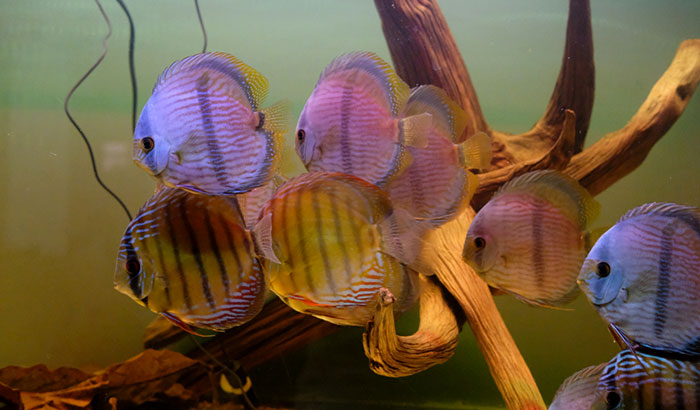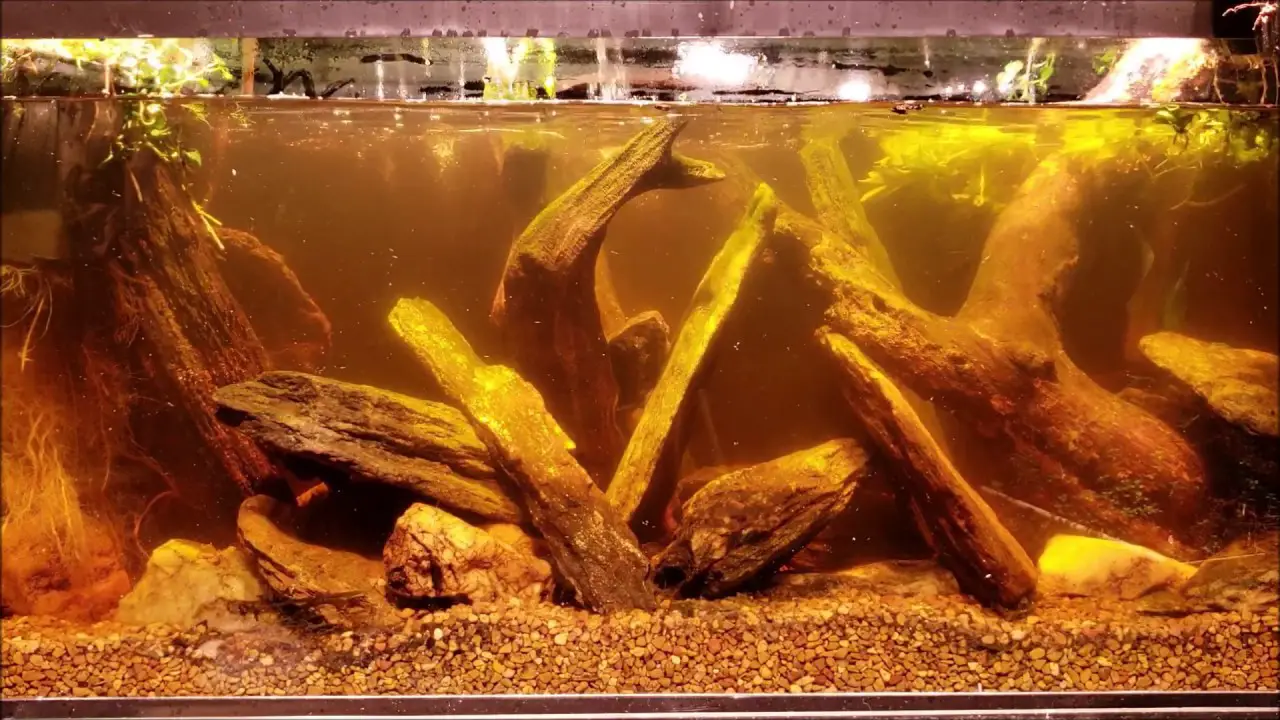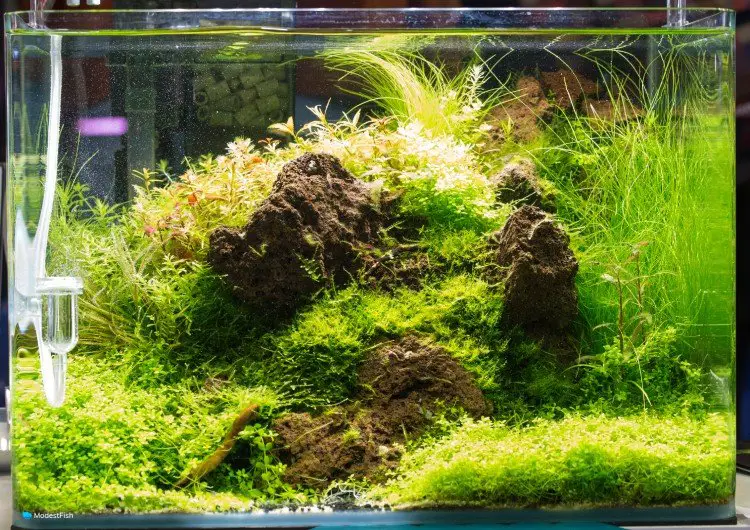How to Remove Tannins from Aquarium Water?
Tannins are organic compounds that can give your aquarium water an unpleasant yellow or brown tint. Removing tannins from aquarium water is a fairly simple process and can be done in three steps:
1) Firstly, increase the frequency of partial water changes to remove some of the tannin-rich water.
2) Secondly, use activated carbon filtration as it helps to absorb dissolved organics like tannins from your tank’s water column.
3) Finally, install a reverse osmosis (RO) filter on your aquarium system as it can reduce up to 99% of all ions and nutrients found in tap water which include tannins. After installing an RO filter you should also perform regular maintenance such as replacing old filters frequently and cleaning prefilters regularly for optimal performance.
- Increase Water Movement: Increasing water movement in your aquarium can help to reduce the amount of tannins present in the tank by increasing circulation throughout the water column and helping to break up any sediment that may be contributing to the high levels of tannins
- This can be accomplished through the use of a power filter or air pump
- Utilize Activated Carbon: Activated carbon is an effective way of removing organic compounds such as tannins from aquarium water, making it one of the most popular methods used by aquarists for this purpose
- Simply add activated carbon to your filter media and allow it time to absorb any excess organics including tannins from your tank’s water column
- Perform Frequent Partial Water Changes: Performing frequent partial water changes will not only help lower nitrate levels but also help remove some dissolved organics like tannin-producing substances from your aquarium’s environment over time, thus reducing their concentration within your tank’s waterscape
- 4 Add Live Plants To Your Tank: Adding live plants and other aquatic vegetation into yout aquarium will go a long way towards reducing overall concentrations of tannin-producing substances in addition ot providing many beneficial effects for fish health too! Doing so will create competition between plant roots and suspended particles, which helps keep these organic compounds filtered out more effectively than they would otherwise be with just mechanical filtration alone!
Purigen Remove Tannins
Purigen is an excellent way to remove tannins from aquarium water. Tannins are organic compounds that can give your tank a yellowish tint, and while they generally aren’t harmful, many aquarists don’t like the appearance of them in their tanks. Purigen works by binding with tannins and other organics in the water column and removing them through regular filter maintenance or water changes.
In addition to removing tannins, Purigen also helps eliminate odors, reduce nitrates, and stabilize pH levels for healthier fish and plants.
How Long Do Tannins Stay in Aquarium
Tannins in aquariums can stay for a long time, depending on the type of water used and how often it is changed. Generally, when using tap water that contains tannins, they can last up to several months or even years if the tank is not disturbed. However, regular partial water changes will help reduce the amount of tannins present in an aquarium over time.
Tannin levels can also be reduced by using activated carbon or other chemical filtration media such as Poly-Filter® pads.
How Many Water Changes to Remove Tannins
Water changes are a great way to reduce the amount of tannins in your aquarium. Depending on how many tannins are present and the size of your tank, it is recommended that you do at least 10-15% water changes per week over a period of several weeks to effectively remove the tannins from your aquarium. Doing smaller water changes more often can also be beneficial when trying to reduce tannin levels.
Bio Chem Zorb
Bio Chem Zorb is a patented technology developed by Bio-Chem Laboratories, Inc. that uses natural enzymes to break down organic waste and convert it into an environmentally friendly fertilizer or soil conditioner. It works by breaking down complex molecules in food, paper products, and other organic materials into smaller compounds that can be used as plant nutrients or soil amendments. This process reduces the amount of solid waste requiring disposal while providing important nutrients for plants.
How to Remove Tannins from Aquarium Wood
Removing tannins from aquarium wood is an important step in providing a healthy environment for your fish. Tannins, which are organic compounds that can leech out of certain types of wood, can discolor the water and cause pH changes. To remove tannins, you should first rinse off any dirt or debris from the wood with tap water.
Then, place the pieces into a bucket or container filled with dechlorinated water and allow it to soak for up to 24 hours. During this time, regular water changes should be done to ensure that all tannin molecules have been removed. After removing the pieces from their soaking solution, they’re ready to use in your aquarium!
How to Keep Tannins in Aquarium
Tannins are a natural part of many aquarium ecosystems, and they can be beneficial to aquatic life by providing essential trace elements and helping maintain pH levels. To keep tannins in your aquarium, you can use driftwood or other natural sources like oak leaves or peat moss. Additionally, blackwater extracts from speciality stores are also effective for introducing tannins into the water column.
Regular water changes will help keep these compounds within safe levels, as well as adding carbon filtration media to remove any excess tannin deposits that may accumulate over time.
Can Tannins Kill Fish
Tannins are naturally occurring compounds found in the leaves and bark of many plants, as well as in tea. While these compounds can be beneficial for fish when present in moderate concentrations, high levels of tannins can cause a depletion of oxygen which can ultimately lead to the death of fish. Therefore, it is important to ensure that aquariums do not contain an excessive amount of tannins or other organic matter if one wishes to keep their aquatic inhabitants safe and healthy.
Benefits of Tannins in Aquarium
Tannins are a beneficial component of an aquarium environment. Tannins released from driftwood, botanicals or peat moss can help lower the pH in an aquarium, making it more hospitable for many species of fish. Additionally, tannins are known to reduce stress levels in aquatic life by simulating their natural environment and providing beneficial shade and hiding places.
Tannins also create a more natural looking water color due to its unique yellow-brown hue that is pleasing to look at.

Credit: www.aquatic-eden.com
How Do You Get Tannins Out of a Fish Tank?
If you have fish in your tank, it’s important to make sure that the water is free of tannins. Tannins are organic compounds found naturally in plants and can be released into water through decaying plant material. Tannins give aquarium water a yellowish or brown tint, and if left unchecked they can reduce the oxygen levels in the tank which can negatively affect your fish.
Fortunately, there are some simple steps you can take to get rid of these pesky tannins from your aquarium. The first step is to remove any excess organic matter from the bottom of the tank such as leaves or other debris that may be releasing tannins into the water. You should also perform regular partial water changes (at least 25%) every two weeks to help prevent build up.
This will also allow for more efficient filtration as well as helping keep pH levels balanced which helps stop new tannin deposits from forming. If you’re still having issues with high amounts of tanning after taking those steps then try adding activated carbon or peat moss to your filter media which will work effectively at absorbing any remaining particles in your aquarium water while simultaneously making it look crystal clear!
How Long Does It Take for Tannins to Go Away?
The answer to the question of how long it takes for tannins to go away depends on a few factors, such as the type of tannin and the environmental conditions. Generally speaking, chemical tannins typically take anywhere from one week up to a month or more to dissipate, while non-chemical based tannins may take several months or even years. Temperature also plays an important role in how quickly tannins will break down; warm water temperatures speed up the process while cold water can slow it down significantly.
Additionally, adequate aeration is essential as oxygen helps break down compounds like tanning agents faster than if they are completely deprived of air. Lastly, natural sunlight exposure has been known to reduce levels of dissolved organic matter (including certain types of tanning agents) over time when exposed consistently. Ultimately, understanding all these variables and testing your own environment before attempting any treatments is always recommended so that you can accurately determine just how long it should take for your particular situation and set expectations accordingly.
What Chemical Removes Tannins from Aquarium Water?
Activated carbon is an effective chemical for removing tannins from aquarium water. It works by trapping toxins and organic compounds, such as tannins, in its tiny pores. Activated carbon also helps clear up cloudy water caused by the presence of organic matter like leaves or fish waste.
Additionally, it can improve water clarity by eliminating discoloration caused by these same materials. The best thing about activated carbon is that it’s a safe and cost-effective way to remove tannins from your aquarium without harming your fish or other aquatic life. To use activated carbon effectively, you should follow the instructions on the packaging and make sure to replace it regularly (typically every two weeks).
Once replaced, simply rinse off any remaining particles before adding them back into your tank. With this simple process in mind, you’ll be able to keep tannin levels low in no time!
What Clears Tannins?
Tannins are naturally occurring compounds found in many plants and can be responsible for the astringent taste of some food. Fortunately, there are a few methods available to clear tannins from your food or drink. Boiling is usually the simplest solution; heating up your water or other liquid will cause the tannin molecules to break down.
Filtration is another option that works well with liquids such as tea and wine – using a coffee filter, cheese cloth, activated carbon filter, or any other type of microporous material can help remove tannins from your beverage. Lastly, adding certain substances like baking soda or egg whites can neutralize these compounds and make them less noticeable in taste tests. Ultimately though, if you’re looking for a quick fix to reduce tannin levels then boiling may be the best choice since it’s relatively simple and efficient!
Remove Yellow Tannin Water from Aquarium
Conclusion
Removing tannins from aquarium water can be done in a variety of ways, and with the right techniques, it’s an easy process that will ensure your tank is clean and healthy. Boiling driftwood or using activated carbon are two common methods to remove tannins, but other products such as reverse osmosis systems may also help. Ultimately, the best way to keep your tank free from tannins is to maintain proper filtration and regular water changes.
By following these steps you can ensure your aquarium stays crystal clear for years to come!





